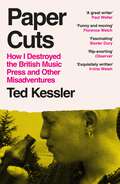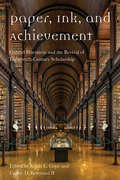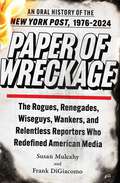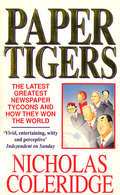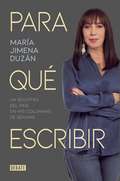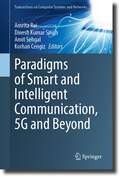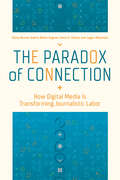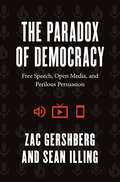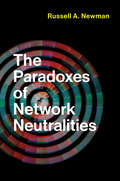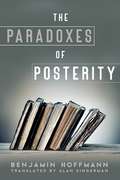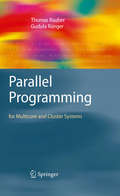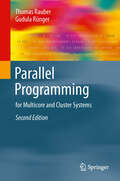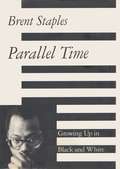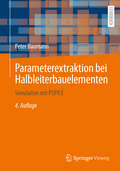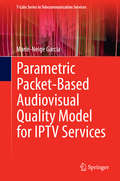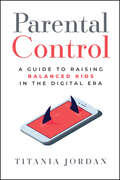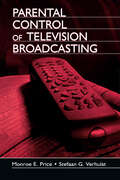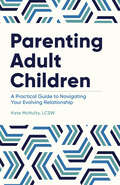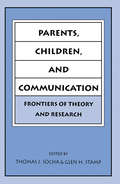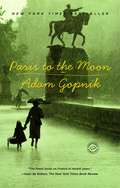- Table View
- List View
Paper Cuts: How I Destroyed the British Music Press and Other Misadventures
by Ted Kessler'A great writer' Paul Weller'A music journalist of integrity' Billy Childish'There's only one Ted Kessler!' Liam GallagherPAPER CUTS is the inside story of the slow death of the British music press. But it's also a love letter to it, the tale of how music magazines saved one man's life. Ted Kessler left home and school around his seventeenth birthday, determined 'to be someone who listened to music professionally'. That dream appeared forlorn when he was later arrested for theft behind the counter of the record shop he managed during acid house's long hot summer of love. Paper Cuts tells how Kessler found redemption through music and writing and takes us on a journey alongside the stars he interviewed and the work-place dramas he navigated as a senior staffer at NME through the boom-time '90s and on to the monthly Q in 2004, where he worked for sixteen years before it folded with him at its helm as editor in 2020.We travel in time alongside musical heroes Paul Weller, Kevin Rowland, Mark E Smith, and to Cuba twice, first with Shaun Ryder and Bez, then with Manic Street Preachers. We spend long, mad nights out with Oasis and The Strokes, quality time with Jeff Buckley and Florence Welch, and watch Radiohead deliver cold revenge upon Kessler in public. A story about love and death, about what it's like when a music writer shacks up with a conflict of interest, and what happens when your younger brother starts appearing on the cover of the magazines you work for, this is the memoir of "a delinquent doofus" whose life was both rescued and defined by music magazines.
Paper Cuts: How I Destroyed the British Music Press and Other Misadventures
by Ted Kessler'A great writer' Paul Weller'A music journalist of integrity' Billy Childish'There's only one Ted Kessler!' Liam GallagherPAPER CUTS is the inside story of the slow death of the British music press. But it's also a love letter to it, the tale of how music magazines saved one man's life. Ted Kessler left home and school around his seventeenth birthday, determined 'to be someone who listened to music professionally'. That dream appeared forlorn when he was later arrested for theft behind the counter of the record shop he managed during acid house's long hot summer of love. Paper Cuts tells how Kessler found redemption through music and writing and takes us on a journey alongside the stars he interviewed and the work-place dramas he navigated as a senior staffer at NME through the boom-time '90s and on to the monthly Q in 2004, where he worked for sixteen years before it folded with him at its helm as editor in 2020.We travel in time alongside musical heroes Paul Weller, Kevin Rowland, Mark E Smith, and to Cuba twice, first with Shaun Ryder and Bez, then with Manic Street Preachers. We spend long, mad nights out with Oasis and The Strokes, quality time with Jeff Buckley and Florence Welch, and watch Radiohead deliver cold revenge upon Kessler in public. A story about love and death, about what it's like when a music writer shacks up with a conflict of interest, and what happens when your younger brother starts appearing on the cover of the magazines you work for, this is the memoir of "a delinquent doofus" whose life was both rescued and defined by music magazines.
Paper, Ink, and Achievement: Gabriel Hornstein and the Revival of Eighteenth-Century Scholarship
by James E May Leah Orr J. T. Scanlan Susan Spencer Linda V. Troost Manuel Schonhorn Brett C. McInelly David Venturo Philip SmallwoodDuring his forty-two years as president of AMS Press, Gabriel Hornstein quietly sponsored and stimulated the revival of “long” eighteenth-century studies. Whether by reanimating long-running research publications; by creating scholarly journals; or by converting daring ideas into lauded books, “Gabe” initiated a golden age of Enlightenment scholarship. This understated publishing magnate created a global audience for a research specialty that many scholars dismissed as antiquarianism. Paper, Ink, and Achievement finds in the career of this impresario a vantage point on the modern study of the Enlightenment. An introduction discusses Hornstein’s life and achievements, revealing the breadth of his influence on our understanding of the early days of modernity. Three sets of essays open perspectives on the business of long-eighteenth-century studies: on the role of publishers, printers, and bibliophiles in manufacturing cultural legacies; on authors whose standing has been made or eclipsed by the book culture; and on literary modes that have defined, delimited, or directed Enlightenment studies. Published by Bucknell University Press. Distributed worldwide by Rutgers University Press.
Paper of Wreckage: The Rogues, Renegades, Wiseguys, Wankers, and Relentless Reporters Who Redefined American Media
by Susan Mulcahy Frank DiGiacomoA jaw-dropping and unputdownable oral history of the New York Post and the legendary tabloid&’s cultural impact from the 1970s to today as recounted by the men and women who witnessed it firsthand. By the 1970s, the country&’s oldest continuously published newspaper had fallen on hard times, just like its nearly bankrupt hometown. When the New York Post was sold to a largely unknown Australian named Rupert Murdoch in 1976, staffers hoped it would be the start of a new golden age for the paper. Now, after the nearly fifty years Murdoch has owned the tabloid, American culture reflects what Murdoch first started in the 1970s: a celebrity-focused, noisy, one-sided media empire that reached its zenith with Fox News. Drawing on extensive interviews with key players and in-depth research, this eye-opening, wildly entertaining oral history shows us how we got to this point. It&’s a rollicking tale full of bad behavior, inflated egos, and a corporate culture that rewarded skirting the rules and breaking norms. But working there was never boring and now, you can discover the entire remarkable true story of America&’s favorite tabloid newspaper.
Paper Tigers
by Nicholas ColeridgePaper Tigers is a riveting, authoritative and in-depth study of newspaper barons of the world – men and women who wield immense power, and whose ever-changing media empires make compelling case studies of business success and failure.From Rupert Murdoch to Robert Maxwell, Conrad Black to Lord Rothermere, Katharine Graham to Punch Sulzberger, Coleridge interviewed them all. The results confirm his status as a devastatingly astute observer of our times, one with few equals today.
Paper Trails: From the Backwoods to the Front Page, a Life in Stories
by Roy MacGregorOne of Canada's greatest journalists shares a half century of the stories behind the stories.From his vantage point harnessed to a tree overlooking the town of Huntsville (he tended to wander), a very young Roy MacGregor got in the habit of watching people—what they did, who they talked to, where they went. He has been getting to know his fellow Canadians and telling us all about them ever since. From his early days in the pages of Maclean's, to stints at the Toronto Star, Ottawa Citizen, National Post and most famously from his perch on page two of the Globe and Mail, MacGregor was one of the country's must-read journalists. While news media were leaning increasingly right or left, he always leaned north, his curiosity trained by the deep woods and cold lakes of Algonquin Park to share stories from Canada's farthest reaches, even as he worked in the newsrooms of its southern capitols. From Parliament to the backyard rink, subarctic shores to prairie expanses, MacGregor shaped the way Canadians saw and thought about themselves—never entirely untethered from the land and its history. When MacGregor was still a young editor at Maclean's, the 21-year-old chief of the Waskaganish (aka Rupert's House) Crees, Billy Diamond, found in Roy a willing listener as the chief was appealing desperately to newsrooms across Ottawa, trying to bring attention to the tainted-water emergency in his community. Where other journalists had shrugged off Diamond's appeals, MacGregor got on a tiny plane into northern Quebec. From there began a long friendship that would one day lead MacGregor to a Winnipeg secret location with Elijah Harper and his advisors, a host of the most influential Indigenous leaders in Canada, as the Manitoba MPP contemplated the Charlottetown Accord and a vote that could shatter what seemed at the time the country's last chance to save Confederation. This was the sort of exclusive access to vital Canadian stories that Roy MacGregor always seemed to secure. And as his ardent fans will discover, the observant small-town boy turned pre-eminent journalist put his rare vantage point to exceptional use. Filled with reminiscences of an age when Canadian newsrooms were populated by outsized characters, outright rogues and passionate practitioners, the unputdownable Paper Trails is a must-read account of a life lived in stories.
Para qué escribir
by María Jimena DuzanUna recopilación de las mejores columnas de una de las mejores periodistas del país. Por más de una década la revista Semana ha publicado las columnas, entrevistas y crónicas de María Jimena Duzán. En estas ha quedado un registro de la realidad política del país, de los líderes y las fuerzas que compiten por el poder, así como de escandalosas formas de corrupción y graves atentados a la democracia; en sus investigaciones, Duzán elabora los grandes temas que ocupan el interés colectivo en un momento en que la sociedad ve pasar ante sí hechos que marcan el rumbo de su historia, como fueron desactivar una guerra y la vuelta de los gobiernos de derecha en el continente. En esta selección de sus mejores textos para la revista, María Jimena Duzán pone en perspectiva el oficio de periodista y su migración a las redes sociales. Su capacidad para escudriñar los fondos del poder junto a un gran talento para la investigación y el análisis de la coyuntura, la han convertido en una de las columnistas.
Paradigms of Smart and Intelligent Communication, 5G and Beyond (Transactions on Computer Systems and Networks)
by Amrita Rai Dinesh Kumar Singh Amit Sehgal Korhan CengizThis book focuses on both theory and applications of Artificial Intelligence and Machine Learning in the broad areas of communication and networking. This book focuses on the ongoing research work and future scope for various open research issues related to sustainable design, development, and analysis of smart communication, 5G and beyond, with the integration of Artificial intelligence and IoT. It addresses fundamental technology components for 5G and beyond, which include modern advancements in communication and networking in a real-world application. The book presents the convergence of Artificial Intelligence, Machine Learning, and IoT with 5G and beyond wireless networks to give some ice-breaking solutions in radio resource allocation, network management, and cybersecurity. This book will be a valuable resource for academicians, researchers, and professionals working in artificial intelligence/machine learning and its applications in communication and 5G.
Paradox in Public Relations: A Contrarian Critique of Theory and Practice (Routledge New Directions in PR & Communication Research)
by Kevin L. StokerParadox in Public Relations: A Contrarian Critique of Theory and Practice is a thought-provoking exploration of public relations, aiming to promote changes in meaning and perception by creating new meta-realities for public relations. The term “Public Relations” was embraced by early practitioners primarily because it sounded more professional than the often-pejorative alternatives. This book argues for a reframing of some of the popular realities associated with modern-day public relations and uses psychological and organizational change theory to critique paradoxes in public relations theory and practice. By examining public relations through the lens of paradox, we can begin to identify the logical fallacies that have inhibited progress and innovation in public relations practice and theory. The book explores the paradoxical nature of key concepts, including public interest, relationship management, accountability, stewardship, loyalty, community, and ethics. It also recommends new conceptualizations for understanding the field. This book will be of interest to media, communication, public relations, and advertising faculty and graduate students, particularly those interested in public relations theory and ethics. Scholars from other disciplines can also use this exploration of paradox in PR as a learning tool for identifying logical fallacies and inconsistencies.
The Paradox of Connection: How Digital Media Is Transforming Journalistic Labor
by Diana Bossio Valérie Bélair-Gagnon Avery E. Holton Logan MolyneuxUsing a framework of online connection and disconnection, The Paradox of Connection examines how journalists’ practices are formed, negotiated, and maintained in dynamic social media environments. The interactions of journalists with the technological, social, and cultural features of online and social media environments have shaped new values and competencies--and the combination of these factors influence online work practices. Merging case studies with analysis, the authors show how the tactics of online connection and disconnection interact with the complex realities of working in today’s media environments. The result is an insightful portrait of fast-changing journalistic practices and their implications for both audiences and professional identities and norms.
The Paradox of Democracy: Free Speech, Open Media, and Perilous Persuasion
by Zac Gershberg Sean IllingA thought-provoking history of communications that challenges ideas about freedom of speech and democracy. At the heart of democracy lies a contradiction that cannot be resolved, one that has affected free societies since their advent: Though freedom of speech and media has always been a necessary condition of democracy, that very freedom is also its greatest threat. When new forms of communication arrive, they often bolster the practices of democratic politics. But the more accessible the media of a society, the more susceptible that society is to demagoguery, distraction, and spectacle. Tracing the history of media disruption and the various responses to it over time, Zac Gershberg and Sean Illing reveal how these changes have challenged democracy—often with unsettling effects. The Paradox of Democracy captures the deep connection between communication and political culture, from the ancient art of rhetoric and the revolutionary role of newspapers to liberal broadcast media and the toxic misinformation of the digital public sphere. With clear-eyed analysis, Gershberg and Illing show that our contemporary debates over media, populism, and cancel culture are not too different from the democratic cultural experiences of the past. As we grapple with a fast-changing, hyper-digital world, they prove democracy is always perched precipitously on a razor’s edge, now as ever before.
The Paradoxes of Network Neutralities (Information Policy)
by Russell A. NewmanAn argument that the movement for network neutrality was of a piece with its neoliberal environment, solidifying the continued existence of a commercially driven internet.Media reform activists rejoiced in 2015 when the FCC codified network neutrality, approving a set of Open Internet rules that prohibitedproviders from favoring some content and applications over others—only to have their hopes dashed two years later when the agency reversed itself. In this book, Russell Newman offers a unique perspective on these events, arguing that the movement for network neutrality was of a piece with its neoliberal environment rather than counter to it; perversely, it served to solidify the continued existence of a commercially dominant internet and even emergent modes of surveillance and platform capitalism. Going beyond the usual policy narrative of open versus closed networks, or public interest versus corporate power, Newman uses network neutrality as a lens through which to examine the ways that neoliberalism renews and reconstitutes itself, the limits of particular forms of activism, and the shaping of future regulatory processes and policies.Newman explores the debate's roots in the 1990s movement for open access, the transition to network neutrality battles in the 2000s, and the terms in which these battles were fought. By 2017, the debate had become unmoored from its own origins, and an emerging struggle against “neoliberal sincerity” points to a need to rethink activism surrounding media policy reform itself.
The Paradoxes of Posterity (G - Reference,information And Interdisciplinary Subjects Ser.)
by Benjamin HoffmannThe impetus for literary creation has often been explained as an attempt to transcend the mortality of the human condition through a work addressed to future generations. Failing to obtain literal immortality, or to turn their hope towards the spiritual immortality promised by religious systems, literary creators seek a symbolic form of perpetuity granted to the intellectual side of their person in the memory of those not yet born while they write. In this book, Benjamin Hoffmann illuminates the paradoxes inherent in the search for symbolic immortality, arguing that the time has come to find a new answer to the perennial question: Why do people write?Exploring the fields of digital humanities and book history, Hoffmann describes posterity as a network of interconnected memories that constantly evolves by reserving a variable and continuously renegotiated place for works and authors of the past. In other words, the perpetual safeguarding of texts is delegated to a collectivity not only nonexistent at the moment when a writer addresses it, but whose nature is characterized by impermanence and instability. Focusing on key works by Denis Diderot, Étienne-Maurice Falconet, Giacomo Casanova, François-René de Chateaubriand, and Jean-Paul Sartre, Hoffmann considers the authors’ representations of posterity, the representation of authors by posterity, and how to register and preserve works in the network of memories. In doing so, Hoffmann reveals the three great paradoxes in the quest for symbolic immortality: the paradoxes of belief, of identity, and of mediation.Theoretically sophisticated and convincingly argued, this book contends that there is only one truly serious literary problem: the transmission of texts to posterity. It will appeal to specialists in literature, in particular eighteenth-century French literature, as well as scholars and students of philosophy and book history.
The Paradoxes of Posterity
by Benjamin HoffmannThe impetus for literary creation has often been explained as an attempt to transcend the mortality of the human condition through a work addressed to future generations. Failing to obtain literal immortality, or to turn their hope toward the spiritual immortality promised by religious systems, literary creators seek a symbolic form of perpetuity granted to the intellectual side of their person in the memory of those not yet born while they write. In this book, Benjamin Hoffmann illuminates the paradoxes inherent in the search for symbolic immortality, arguing that the time has come to find a new answer to a perennial question: Why do people write?Exploring the fields of digital humanities and book history, Hoffmann describes posterity as a network of interconnected memories that constantly evolves by reserving a variable and continuously renegotiated place for works and authors of the past. In other words, the perpetual safeguarding of texts is delegated to a collectivity that is nonexistent at the moment when a writer addresses it, one whose nature is characterized by impermanence and instability. Focusing on key works by Denis Diderot, Étienne-Maurice Falconet, Giacomo Casanova, François-René de Chateaubriand, and Jean-Paul Sartre, Hoffmann considers the authors’ representations of posterity, the representation of authors by posterity, and how to register and preserve works in the network of memories. In doing so, Hoffmann reveals the three great paradoxes in the quest for symbolic immortality: the paradoxes of belief, of identity, and of mediation.Theoretically sophisticated and convincingly argued, this book contends that there is only one truly serious literary problem: the transmission of texts to posterity. It will appeal to specialists in literature, in particular eighteenth-century French literature, as well as scholars and students of philosophy and book history.
Parallel Programming
by Thomas Rauber Gudula RüngerInnovations in hardware architecture, like hyper-threading or multicore processors, mean that parallel computing resources are available for inexpensive desktop computers. In only a few years, many standard software products will be based on concepts of parallel programming implemented on such hardware, and the range of applications will be much broader than that of scientific computing, up to now the main application area for parallel computing. Rauber and Rünger take up these recent developments in processor architecture by giving detailed descriptions of parallel programming techniques that are necessary for developing efficient programs for multicore processors as well as for parallel cluster systems and supercomputers. Their book is structured in three main parts, covering all areas of parallel computing: the architecture of parallel systems, parallel programming models and environments, and the implementation of efficient application algorithms. The emphasis lies on parallel programming techniques needed for different architectures. The main goal of the book is to present parallel programming techniques that can be used in many situations for many application areas and which enable the reader to develop correct and efficient parallel programs. Many examples and exercises are provided to show how to apply the techniques. The book can be used as both a textbook for students and a reference book for professionals. The presented material has been used for courses in parallel programming at different universities for many years.
Parallel Programming: for Multicore and Cluster Systems
by Gudula Rünger Thomas RauberInnovations in hardware architecture, like hyper-threading or multicore processors, mean that parallel computing resources are available for inexpensive desktop computers. In only a few years, many standard software products will be based on concepts of parallel programming implemented on such hardware, and the range of applications will be much broader than that of scientific computing, up to now the main application area for parallel computing. Rauber and Rünger take up these recent developments in processor architecture by giving detailed descriptions of parallel programming techniques that are necessary for developing efficient programs for multicore processors as well as for parallel cluster systems and supercomputers. Their book is structured in three main parts, covering all areas of parallel computing: the architecture of parallel systems, parallel programming models and environments, and the implementation of efficient application algorithms. The emphasis lies on parallel programming techniques needed for different architectures. For this second edition, all chapters have been carefully revised. The chapter on architecture of parallel systems has been updated considerably, with a greater emphasis on the architecture of multicore systems and adding new material on the latest developments in computer architecture. Lastly, a completely new chapter on general-purpose GPUs and the corresponding programming techniques has been added. The main goal of the book is to present parallel programming techniques that can be used in many situations for a broad range of application areas and which enable the reader to develop correct and efficient parallel programs. Many examples and exercises are provided to show how to apply the techniques. The book can be used as both a textbook for students and a reference book for professionals. The material presented has been used for courses in parallel programming at different universities for many years.
Parallel Time
by Brent Staples<P>Parallel Time is an evocative memoir that poses universal questions: Where does the family end and the self begin? What do we owe our families, and what do we owe our dreams for ourselves? What part of the past is a gift and what part a shackle? <P>For Brent Staples there is the added dimension of race: moving from a black world into one largely defined by whites. <P>The oldest song among nine children, Brent grew up in a small industrial town near Philadelphia. <P>First a scholarship to a local college and then one for graduate study at the University of Chicago pulled him out of the close family circle. <P>While he was away, the industries that supported the town failed, and drug dealing rushed in to fill the economic void. <P>News of arrests and premature deaths among Brent's childhood friends underscored the precariousness of his perch in a world of mostly white achievers. A younger brother became a cocaine dealer and was murdered by one of his "clients." <P>His death propelled Brent into a reconsideration of his childhood and coming-of-age that offers vivid portraits of family and place, of values that supported and pressures that tore apart, of the appeal and pain of entering a predominantly white world, and of the strengths and vulnerabilities of the black world he grew away from.
Parameterextraktion bei Halbleiterbauelementen: Simulation mit PSPICE
by Peter BaumannErgänzend zu Vorlesung, zu Rechenübungen und insbesondere zum Laborpraktikum im Lehrfach Elektronik werden Analyseverfahren zur Extraktion von SPICE-Modellparametern ausgewählter Halbleiterbauelemente vorgestellt. Für Bauelemente aus der DEMO-Version des Programms ORCAD-PSPICE wird aufgezeigt, wie man deren statische und dynamische elektrische Modellparameter mit PSPICE-Analysen wieder zurück gewinnen kann. Diese Parameterermittlung wird ausgeführt für Schaltdiode, Kapazitätsdiode, npn-Bipolartransistor, N-Kanal-Sperrschicht-Feldeffekttransistor, CMOS-Array-Transistoren, Operationsverstärker und Optokoppler. In einem neuen Abschnitt werden Streuparameter-Analysen zum bipolaren HF-Transistor vorgenommen. Behandelt wird ferner die Ermittlung der Modellparameter von Sensoren zur Erfassung von Temperatur, Licht, Feuchte, Kraft, Schall, Gaskonzentration und pH-Wert. Das abschließende neue Kapitel widmet sich der Parameterextraktion von multikristallinen, monokristallinen und Dünnschicht-Silizium-Solarzellen.
Parametric Packet-based Audiovisual Quality Model for IPTV services
by Marie-Neige GarciaThis volume presents a parametric, packet-based, comprehensive model to measure and predict the audiovisual quality of Internet Protocol Television services as it is likely to be perceived by the user. The comprehensive model is divided into three sub-models referred to as the audio model, the video model, and the audiovisual model. The audio and video models take as input a parametric description of the audiovisual processing path, and deliver distinct estimates for both the audio and video quality. These distinct estimates are eventually used as input data for the audiovisual model. This model provides an overall estimate of the perceived audiovisual quality in total. The parametric description can be used as diagnostic information. The quality estimates and diagnostic information can be practically applied to enhance network deployment and operations. Two applications come to mind in particular: Network planning and network service quality monitoring. The audio model can be used indifferently for both applications. However, two variants of the video model have been developed in order to address particular needs of the applications mentioned above. The comprehensive model covers effects due to resolution, coding, and IP-packet loss in case of RTP-type transport. The model applied to quality monitoring is standardized under the ITU-T Recommendations P. 1201 and P. 1201. 2.
Parental Control: A Guide to Raising Balanced Kids in the Digital Era
by Titania JordanPractical strategies and tips to help raise and teach children in a digital-first world In Parental Control: A Guide to Raising Balanced Kids in the Digital Era, Titania Jordan, a renowned internet and social media safety specialist, tackles the urgent dilemmas of modern parenting head-on. As technology increasingly engulfs the lives of our children, this book emerges as a beacon for those looking to guide, protect, and connect with them in meaningful ways. Navigating the complex digital landscape, Jordan delves into the effects of social media and the internet on our kids. She uncovers the challenges of balancing screen time with real-life interactions and the erosion of offline social skills due to digital immersion. Yet, it's not all dire—Jordan's expert insights offer a pathway to turning potential digital pitfalls into educational opportunities. The book will help you: Learn how to educate and empower the next generation to navigate the internet safely and responsibly Discover actionable advice on setting boundaries, fostering offline interactions, and promoting healthy digital habits. Benefit from the latest internet safety data, trends, and tips to keep your children protected in the digital age Perfect for parents, educators, and caregivers, Parental Control is more than just a book. It's a roadmap to raising well-adjusted children in a technology-driven world. This guide provides the tools you need to ensure technology complements the lives of those you care about, rather than consuming them. If you're looking to navigate the challenges of modern-day parenting with confidence and create a safe, balanced digital environment for your children, then this book is for you.
Parental Control of Television Broadcasting (Routledge Communication Series)
by Monroe E. Price Stefaan VerhulstThis project, originally developed for the European Community, examines parental roles in controlling television programs watched by children in Europe. The structure of the study includes: *an analysis of the technical devices available to assist in parental control of television broadcasting services, including descriptions of devices, their cost, availability, and the infrastructure needed to introduce them; *a corresponding analysis of potential ratings or labeling systems to work in conjunction with or in the place of technical devices, enabling a comparative analysis of rating systems used in film, video, and online services; and *an overview and assessment of the educational and awareness measures in the field of protection of minors and harmful content, providing the data for the review of available considerations in this field of viewer literacy. In addition to these main strands of analysis, the study provides for background information and analysis in the following areas: *an overview of the main media theories focusing on the effect and impact of specific types of content on children and their behavior; *an assessment of the economic impact and social efficacy of different protective measures; and *a comparison of the regulatory contexts and rating systems for film, video, television, and online services concerning the protection of minors from harmful content. This volume is intended for scholars and students in comparative media studies, media policy, and regulation.
Parentheticals in Spoken English
by Nicole DehéTaking both an empirical and a theoretical view of the prosodic phrasing of parentheticals in English, this book reviews the syntactic and prosodic literature on parentheticals along with relevant theoretical work at the syntax-prosody interface. It offers a detailed prosodic analysis of six types of parentheticals - full parenthetical clauses, non-restrictive relative clauses, nominal appositions, comment clauses, reporting verbs, and question tags, all taken from the spoken part of the British Component of the International Corpus of English. To date, the common assumption is that by default, parentheticals are prosodically phrased separately, an assumption which, as this study shows, is not always in line with the predictions made by current prosodic theory. The present study provides new empirical evidence for the prosodic phrasing of parentheticals in spontaneous and semi-spontaneous spoken English, and offers new implications for a theory of linguistic interfaces.
Parenting Adult Children: A Practical Guide to Navigating Your Evolving Relationship
by Kate McNulty LCSWReconnect and strengthen your relationship with your adult child Even though your role as a parent changes when your child is grown, that doesn't necessarily mean it gets any easier. Whether you're facing challenges in your relationship with your adult child or you've simply grown apart, Parenting Adult Children can help you build the skills necessary to overcome hurdles and create a stronger bond. Discover expert advice and focused strategies for establishing a foundation of communication that promotes trust, authenticity, and healthy boundaries. You'll explore your evolving relationship and find guidance for navigating issues with financial stability, substance abuse, in-laws, child-rearing, and more. Parenting Adult Children includes: Real-life scenarios—Read relatable stories that include evidence-based tips and techniques you can apply in your own relationship. An inclusive approach—Get positive, non-judgmental guidance for parenting adult children, designed for diverse families of any belief or background. Intentional communication—Find step-by-step instructions on the best approaches for honest and respectful conversations with your adult child. Build a deeper connection with your adult child with help from Parenting Adult Children.
Parents, Children, and Communication: Frontiers of Theory and Research (Routledge Communication Series)
by Thomas J. Socha Glen H. StampThis is the first edited volume in the communication field to examine parent-child interaction. It creates a framework for future research in this growing area -- family communication, and more specifically, parent-child communication -- and also suggests new areas of communication research among parents and children -- cultural, work-related, taboo topics, family sex discussions, conflict, and abuse. Chapter authors provide thorough coverage of theoretical approaches, new methods, and emerging contexts including lesbian/gay parent-child relationships. In so doing, they bring a communication perspective to enduring problems of discipline, adolescent conflict, and physical child abuse. The text highlights various methodological approaches -- both quantitative and qualitative -- including conversation analysis, grounded theory, participant-observation, and phenomenological interviewing of children. It also introduces and surveys various theoretical approaches -- general systems, developmental, cultural, and intergenerational transmission.
Paris to the Moon: A Family In France (A\vintage Original Ser.)
by Adam GopnikParis. The name alone conjures images of chestnut-lined boulevards, sidewalk cafés, breathtaking façades around every corner--in short, an exquisite romanticism that has captured the American imagination for as long as there have been Americans. In 1995, Adam Gopnik, his wife, and their infant son left the familiar comforts and hassles of New York City for the urbane glamour of the City of Light. Gopnik is a longtime New Yorker writer, and the magazine has sent its writers to Paris for decades--but his was above all a personal pilgrimage to the place that had for so long been the undisputed capital of everything cultural and beautiful. It was also the opportunity to raise a child who would know what it was to romp in the Luxembourg Gardens, to enjoy a croque monsieur in a Left Bank café--a child (and perhaps a father, too) who would have a grasp of that Parisian sense of style we Americans find so elusive. So, in the grand tradition of the American abroad, Gopnik walked the paths of the Tuileries, enjoyed philosophical discussions at his local bistro, wrote as violet twilight fell on the arrondissements. Of course, as readers of Gopnik's beloved and award-winning "Paris Journals" in The New Yorker know, there was also the matter of raising a child and carrying on with day-to-day, not-so-fabled life. Evenings with French intellectuals preceded middle-of-the-night baby feedings; afternoons were filled with trips to the Musée d'Orsay and pinball games; weekday leftovers were eaten while three-star chefs debated a "culinary crisis."As Gopnik describes in this funny and tender book, the dual processes of navigating a foreign city and becoming a parent are not completely dissimilar journeys--both hold new routines, new languages, a new set of rules by which everyday life is lived. With singular wit and insight, Gopnik weaves the magical with the mundane in a wholly delightful, often hilarious look at what it was to be an American family man in Paris at the end of the twentieth century. "We went to Paris for a sentimental reeducation-I did anyway-even though the sentiments we were instructed in were not the ones we were expecting to learn, which I believe is why they call it an education."
